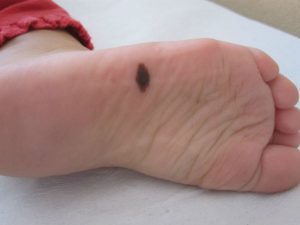You may have come to me with concerns about a mole on your feet or hands. In my experience as a dermatologist, many people have this concern about the appearance of a small spot on the palms of the hands or soles of the feet.
As I have discussed in previous posts, moles, or technically melanocytic nevi, can be present from birth (“congenital nevi”) or can appear throughout life (“acquired melanocytic nevi”), especially during the first 20 years of life.
Both can occur on the feet and hands. They are more common in people with many moles or in dark-skinned people.
What do moles on the feet and hands look like?
They are usually brown patches, millimeters to centimeters in size, circular or oval in shape, and have a “striped” appearance caused by the skin lines on the palms and soles (called dermatoglyphs).
They can be any size and anywhere on the hands and feet. They do not itch or hurt. They should not bleed (if they did, it would be a reason to see a doctor).
Are moles on the feet and hands dangerous?
There is a misconception that moles on the feet are more dangerous than moles elsewhere on the body. This is not the case. Moles that appear on the palms of the hands and soles of the feet are exactly the same in terms of biology and medical characteristics as those we see on other parts of the body. Contrary to popular belief, these moles or nevi are not more dangerous because they are on the palms of the hands or soles of the feet.

Moles on the palms and soles are no more at risk than any others

Well, it is important to insist that monitoring ALL the moles we have on our body is equally important, including, of course, those on our feet and hands.
In fact, perhaps the belief that moles on the soles or toes are more aggressive comes from the fact that if we do not monitor them and a “malignant” change occurs, we would notice it later than if it occurred on, say, an arm, and therefore that lesion would already be more advanced (but not because it is really more aggressive, but because we would have diagnosed it later).
There is no scientific study to support the idea that moles on the palms of the hands and soles of the feet have a higher risk of becoming malignant than those on the rest of the body. Therefore, it is not necessary to remove them. This does not mean that we should not be aware of the importance of keeping an eye on them, ALL OF THE TIME, in order to prevent a melanoma from “escaping”.
I remind you of the ABCDE rule to look for possible changes in moles that should make us consult a dermatologist:
- A. Asymmetry
- B: Edge changes
- C: changes in Color
- D: increase in Diameter
- E: Evolving: the mole is changins in size, shape or color over time.
Are moles on the nails dangerous?

Because moles can appear on any part of the body, it is possible to see them on your nails. When a mole appears in the nail matrix (the area where the nail originates), the pigment it produces grows with the nail and can be seen as a brown line along the nail.
These moles are also no more likely to go bad, although they may be a little more difficult to monitor. In any case, there are some clues that should make us consult a dermatologist:
- The line becomes wider or parallel lines of varying thickness are observed.
- The line has different shades of brown
- The spot not only affects the nail, but also the skin around the nail (the nail fold). This is called “Hutchison’s sign”..
In conclusion…
It is important that we know ourselves well and frequently observe our moles, as well as those of our family. In case of changes in moles (ABCDE rule), whether on the hands, feet or any other part of the body, it is essential to consult a dermatologist (here you have my location) just in case.
Despite the agility and convenience of the system in this case, consulting a dermatologist online may not be entirely conclusive, as it is not possible to perform dermatoscopy, which is usually of great help to us.
Do you have any moles on your feet or hands that concern you?
